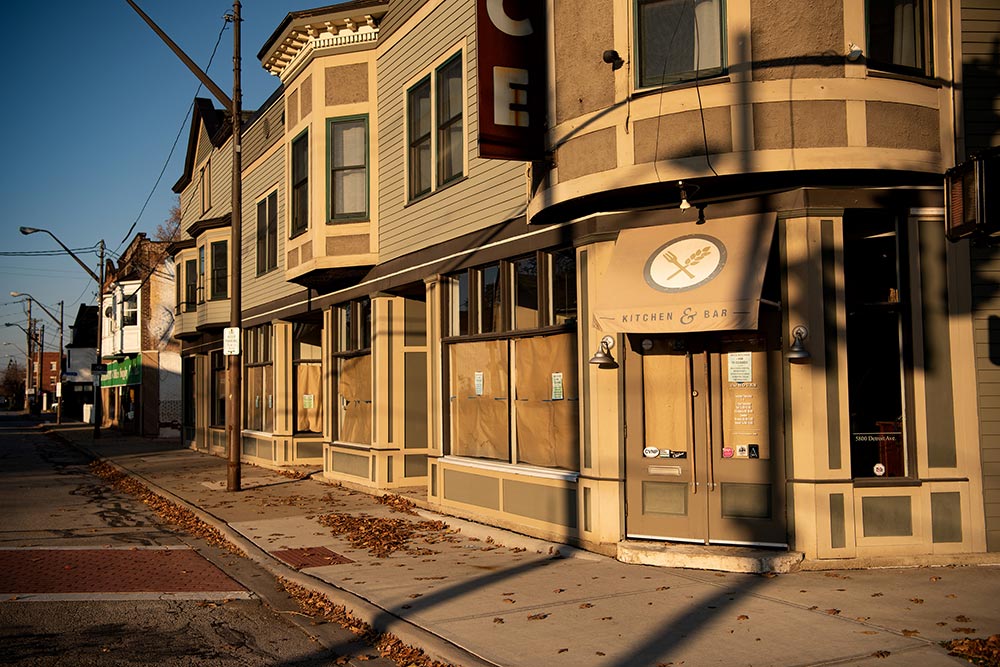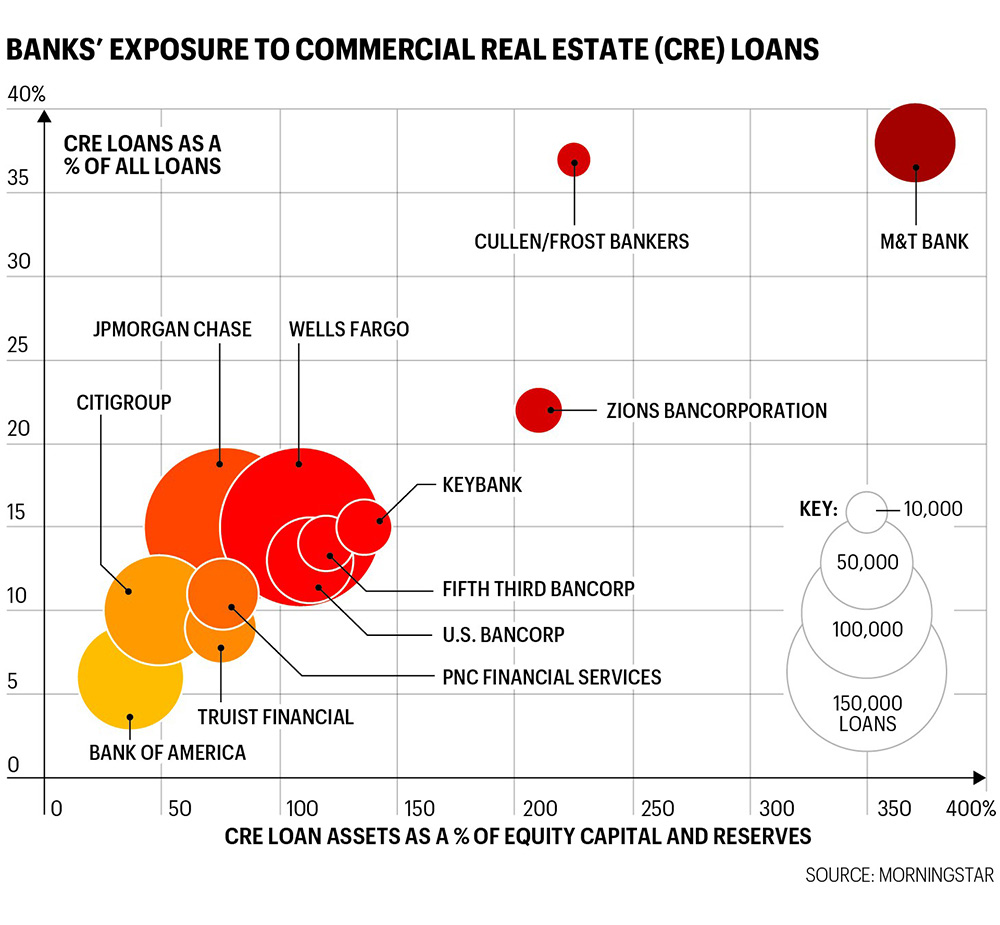
Tattooed Mom酒吧内部从地板到天花板上,都画满了涂鸦。这家位于费城南街的酒吧已经有23年历史,但它却无法阻止追求时髦的主顾们变得精明起来。虽然有忠实顾客选择了外卖用餐,但酒吧所面临的问题是涂鸦难以掩盖的。酒吧无法盈利,销售额比疫情之前下滑了70%。罗伯特•佩里表示,他的酒吧会维持下去,但它附近的许多商铺却难以为继。佩里表示:“在一个街区内就已经有六家餐厅倒闭了。你每周都能听说更多商铺倒闭的消息,这让我很伤心。”
一些传统银行业者可能很快就会有同样的感受。疫情导致酒吧、健身房、酒店等商户生意惨淡,这可能会给商业地产承租人带来危机,导致数十亿美元的贷款出现变数。明尼阿波利斯联邦储备银行行长尼尔•卡什卡利告诉《财富》杂志,商业地产是最脆弱的金融部门,可能会对整个金融体系造成冲击。卡什卡利表示:“数以千计的小企业已经倒闭……这会波及到商业地产市场,并影响到银行业。”
中小银行面临最大的风险。如下图所示,据Morningstar统计,在美国银行和摩根大通,商业地产贷款分别仅占其贷款总额的6%和15%。但在位于大水牛城的M&T银行和来自德克萨斯的库伦佛寺银行,商业地产贷款所占的比例分别高达38%和37%。库伦佛寺银行在1月份进行了近20年来的首次裁员。这些银行都在为贷款违约做准备:2020年,M&T银行将信贷损失风险计提增加到8亿美元,较前一年提高了355%。

任何危机的酝酿时间都可持续数年。除了酒店以外,到目前为止,商业地产并没有出现异常的低价抛售潮。但房地产私募股权基金Corigin的总裁格雷戈•格利森认为,银行和业主为了摆脱空置资产,会低价出售更多商业地产。分析公司CoStar预测,到2022年,低价抛售的商业地产价值将达到1,260亿美元,到2025年将增加到超过3,200亿美元。如果在疫情结束之后,居家办公趋势继续存在,将使办公楼市场陷入危机,未来商业地产的前景可能更糟糕。《财富》与德勤在12月合作开展的CEO调查显示,到目前为止,有75%的公司计划租用更小的办公室。
但卡什卡利认为,只要银行提高对贷款组合的警惕,商业地产风险依旧是可控的。他建议关注全国疫苗接种的推进情况:控制病毒需要的时间越长,就会有更多公司停业,银行所面临的风险就会越高。(财富中文网)
本文发表于2021年2月/3月的《财富》杂志,文章标题为《疫情导致的商业地产危机或将波及银行系统》。
翻译:刘进龙
审校:汪皓
在俄亥俄州克利夫兰的底特律-肖尔韦,一家被永久关闭的餐厅酒吧。摄影:Dustin Franz —— 彭博社/盖蒂图片社
Tattooed Mom酒吧内部从地板到天花板上,都画满了涂鸦。这家位于费城南街的酒吧已经有23年历史,但它却无法阻止追求时髦的主顾们变得精明起来。虽然有忠实顾客选择了外卖用餐,但酒吧所面临的问题是涂鸦难以掩盖的。酒吧无法盈利,销售额比疫情之前下滑了70%。罗伯特•佩里表示,他的酒吧会维持下去,但它附近的许多商铺却难以为继。佩里表示:“在一个街区内就已经有六家餐厅倒闭了。你每周都能听说更多商铺倒闭的消息,这让我很伤心。”
一些传统银行业者可能很快就会有同样的感受。疫情导致酒吧、健身房、酒店等商户生意惨淡,这可能会给商业地产承租人带来危机,导致数十亿美元的贷款出现变数。明尼阿波利斯联邦储备银行行长尼尔•卡什卡利告诉《财富》杂志,商业地产是最脆弱的金融部门,可能会对整个金融体系造成冲击。卡什卡利表示:“数以千计的小企业已经倒闭……这会波及到商业地产市场,并影响到银行业。”
中小银行面临最大的风险。如下图所示,据Morningstar统计,在美国银行和摩根大通,商业地产贷款分别仅占其贷款总额的6%和15%。但在位于大水牛城的M&T银行和来自德克萨斯的库伦佛寺银行,商业地产贷款所占的比例分别高达38%和37%。库伦佛寺银行在1月份进行了近20年来的首次裁员。这些银行都在为贷款违约做准备:2020年,M&T银行将信贷损失风险计提增加到8亿美元,较前一年提高了355%。
任何危机的酝酿时间都可持续数年。除了酒店以外,到目前为止,商业地产并没有出现异常的低价抛售潮。但房地产私募股权基金Corigin的总裁格雷戈•格利森认为,银行和业主为了摆脱空置资产,会低价出售更多商业地产。分析公司CoStar预测,到2022年,低价抛售的商业地产价值将达到1,260亿美元,到2025年将增加到超过3,200亿美元。如果在疫情结束之后,居家办公趋势继续存在,将使办公楼市场陷入危机,未来商业地产的前景可能更糟糕。《财富》与德勤在12月合作开展的CEO调查显示,到目前为止,有75%的公司计划租用更小的办公室。
但卡什卡利认为,只要银行提高对贷款组合的警惕,商业地产风险依旧是可控的。他建议关注全国疫苗接种的推进情况:控制病毒需要的时间越长,就会有更多公司停业,银行所面临的风险就会越高。(财富中文网)
本文发表于2021年2月/3月的《财富》杂志,文章标题为《疫情导致的商业地产危机或将波及银行系统》。
翻译:刘进龙
审校:汪皓
Floor-to-ceiling, the interior of Tattooed Mom is covered in graffiti. The bar, which has been open for 23 years on South Street in Philadelphia, doesn’t stop its hipster patrons from getting crafty. But even with its faithful clientele transitioning to takeout, Tattooed Mom has problems that can’t be painted over. It’s unprofitable, and sales remain down 70% from pre-pandemic levels. Robert Perry says his bar will survive, but many of its neighbors won’t. “Within a one-block radius there are six restaurants that are already gone,” he says. “Every week you read about new closures, and it breaks my heart.”
Some buttoned-down bankers could soon share his pain. As the pandemic wears down bars, gyms, hotels, and other businesses, it runs the risk of causing a commercial real estate (CRE) tenant crisis, which could put billions of dollars’ worth of loans in jeopardy. Neel Kashkari, president of the Federal Reserve Bank of Minneapolis, tells Fortune that CRE is the most vulnerable financial sector—with the potential to cause a shock to the system. “Thousands of small businesses have already or will go under … That rolls up into the commercial real estate market and rolls up into the banking sector,” Kashkari says.
Small to midsize banks face the greatest risk. At Bank of America and JPMorgan Chase, CRE makes up only 6% and 15% of all loans, respectively, according to Morningstar. But that figure is 38% at Buffalo-based M&T Bank and 37% at Texas’s Cullen/Frost Bankers—which in January conducted its first layoffs in nearly two decades. Banks like these are bracing for defaults: In 2020, M&T increased its provision for credit losses to $800 million, up 355% from the prior year.
Any crisis could take years to brew. Outside of hotels, distressed sales of commercial property aren’t abnormally high to date. But Greg Gleason, president of real estate private equity firm Corigin, says more such sales loom, as banks and owners unload vacant assets. Through 2022, analytics firm CoStar forecasts $126 billion in distressed CRE sales, with the total rising to over $320 billion by 2025. The outlook could be grimmer if work-from-home trends outlast the pandemic, creating trouble for office buildings. As of now, 75% of companies plan to use less office space in the future, according to a Fortune survey of CEOs in December in collaboration with Deloitte.
Still, Kashkari says the CRE risks should be manageable if banks are vigilant about their portfolios. Keep an eye on the vaccine rollout, he advises: The longer it takes to tame the virus, the more businesses will close—and the shakier some banks will look.
This article appears in the February/March 2021 issue of Fortune with the headline, "First bars, then banks?"






